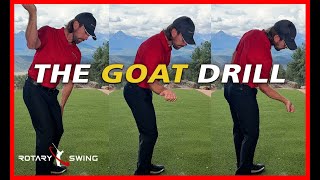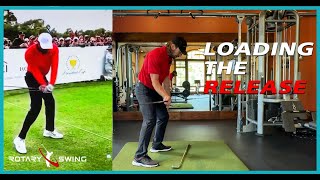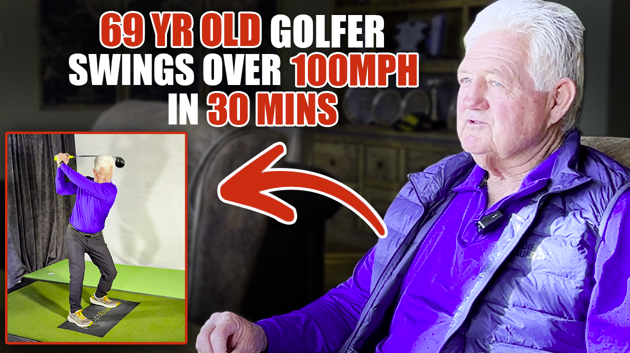An interesting question was posed on the forum recently. Someone asked, "What's the purpose of loading the right leg in the golf swing if you're not going to push off the right leg in the downswing?"
That's a very good question and, like most things in the golf swing, it has a simple answer.
To start out, let's look at why you don't want to push off the right leg in the downswing.
That also has a simple answer.
If you think back to the '60s and '70s, the golf instruction world favored driving off the right leg.
Everyone was teaching that technique, and you saw all the golfers finishing in that classic "Reverse C" posture.
What's Wrong With It?
This technique formed the basis for a lot of modern golf instruction. Nicklaus did it, Watson did it, Miller did it, Weiskopf did it.
All these players used to have this very stylized finish, and all of them also eventually had their hips replaced.
The Reverse C is a posture we all came to associate with good form in golf, but if you don't want to have your hip replaced once or twice during your golfing career, there's got to be a better way - and of course there is.
Your hip is not designed to take a lot of stress in this Reverse C position. The golf swing is a rapid movement with a lot of forces in motion in different directions.
It puts a lot of stress on the body, and whether you do it right or wrong will determine how well your body is able to withstand that stress.
Anatomical Absolutes
To hit the ball a long distance - and to do so safely and powerfully - we have to understand how the body is designed to move.
Once we know the mechanics of our own anatomy, we can design a great golf swing that doesn't damage the body.
We don't teach you push off the right leg in the golf swing because pushing off the right foot is exactly what creates that Reverse C posture, which in turn is what damages your hip.
It's easy to experience this for yourself. Just stand up and lift your right foot up off the ground.
You'll see that you can't really get into the Reverse C posture without that right foot.
It's not a position you would naturally try to assume using the left side of your body.
Instead, your body will want to stand more upright. As you find your balance, you'll find yourself settling in over the main pivot point, which is your left hip.
You'll settle into neutral joint alignment.
Try It Yourself and Feel the Difference
Neutral joint alignment is simply having the center of your hip socket lined up over the center of your ankle. Your joint is designed to pivot safely and efficiently in this position.
As you go ahead and get yourself stacked over that left side you can feel that you're able to pivot very freely, but you'll also be pivoting very upright, versus the Reverse C where the left hip is protruding well beyond neutral.
If you put both feet down and get into the Reverse C, you'll be able to feel the strain in your back.
You'll have an increased side bend, which is very hard on the spine.
Furthermore, this position doesn't give you much freedom to rotate your hip. You'll feel strain on the outside of your leg, the outside of your hip socket, etc.
That's why you don't want to push off your right leg in the golf swing; because it moves you outside of neutral, into a position that restricts rotation and puts unnecessary strain on many parts of your body.
Do This Instead
When you use the left side musculature of the body to move yourself to the left, it naturally pulls you into neutral, where you can post up.
Pushing from the right leg in the downswing to move left offers no such safeguard, and can place you well beyond neutral.
When you do the weight shift to the left in the downswing, you want to pull with the inside of your hip muscles (some of which attach down inside your thigh, so you'll feel it there as well).
When you pull hard and contract your glute and hip muscles, that actually moves you into neutral.
No matter how hard you contract your left-side muscles, you'll stay right in neutral, where you need to be.
When used correctly, your muscles are designed to move your joints to their maximum ability, and no more.
If you didn't have that built-in safety mechanism, every time you extended your arm or leg, you'd risk hyperextending it and damaging elbow or knee.
Your muscles are designed to allow you to use your body, but also to protect it.
The same is true of your hip. Your left-side hip muscles are designed to move you right into neutral, and no farther.
It's a great built-in safety mechanism that lets you get into the right position, pivot freely all day long, turn your hips as much as you want, and not end up way beyond neutral where you'll end up damaging your joints.
Then Why Load the Right Glute in the Golf Swing?
If getting over too far is caused by pushing off the right leg in the golf swing instead of pulling from the left, that brings us back to the original question: Why engage the right glute and get all loaded up on the right side in the backswing if we're not going to push off the right foot?
Think of your golf swing in terms of two halves and two sides.
Your body has an upper and a lower half, of course, and a left and right side, with your sternum or spine forming the center line.
Each half, and each side, has a different role in the golf swing. Your upper half is designed to provide rotation.
Notice in the photo to the right that the golfer's hips are turning a little bit, but most of the rotation is provided by the upper torso.
Don't think of your lower body as providing rotation directly. Its job is to support the upper body's rotation.
Your upper body makes a really big turn; your hips don't turn nearly as much.
If you've been on the forums you've probably seen some of the hip research that we've done with TaylorMade Performance Labs.
The Tour pros don't turn their hips much at all. The hips are providing stability and getting everything ready to go back the other way on the downswing.
Loading into the right glute during the backswing allows you to make a powerful turn and support the fast, aggressive rotation you'll be demanding of your upper body.
The lower body supports that movement; that's its job.
You're not loading the right leg in the golf swing to lunge off of it, but to provide stability.
At full speed, the backswing is pretty quick - you have a lot of dynamic forces happening all at once.
Loading into that right glute stabilizes the swing and keeps it from getting sloppy.
Don't think of it as loading up so you can feel all this power shoving off of it. That would cause too much secondary axis tilt, hip slide, damage to your hip, etc.
Recognize that it's there to provide stability and support for a powerful turn, and you'll start to understand why we load that right glute.
Watch part 2 now to see how you're moving your body in the opposite direction of the pros!

































































































































































































































































































































































































































































































